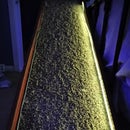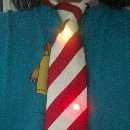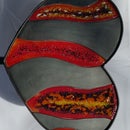Introduction: LED'tennae: LED Antennae for You Cap
Simply put, this is how to build LED antennae for you cap without any soldering.
The genesis for this idea started at a Make Magazine meetup in San Francisco. They had moved in to the old Exploratorium building and invited the public to celebrate the new space. They provided pizza, sodas, beer and a ton of 10mm LEDs of various colors, CR2032 batteries and duct tape and then said have at it. My daughter covered her lanyard, put pupils on a Neff face hoodie, and urged me to put them on my hat. They looked like little nubs atop my cap. After that night I wore the cap around for weeks. In time the duct tape started to give way, it would constantly stick to my hair, and the LEDs would flicker on and off. Also during this time kids and some adults would stare at them, ask what they were or just immediately identify them an antennae, and ask how does it work.
Then I had a LED moment! An army of human-insect hybrids both young and old marching towards city hall demanding the right to co-exist peacefully amongst cranial normals. I thought I'd write up an Instructable and direct folks to the site where they can build their own.
Step 1: Parts and Tools
This is the parts list for the basic build of the LED antennae. To make it truly fun, purchase various color wire, LEDs and chenille stems.
Parts
- Hat that has 2 ventillation holes in the front
- 12" Chenille stems (pipe cleaners), qty x2
- 8" solid core hookup wire, 22 awg, qty x4
- 2-pin Dupont wire connector, female, qty x2
- LED, qty x2
- CR2032 battries, qty x2
- hot glue, optional
- 2" foam tape or sticky back velcro
Tools
- 3D printer
- Needle nose plier
- Wire cutter
This Instructable requires 2 difficult to come by parts: a 3D printed battery holder and a 2-pin Dupont connector. The battery holder was designed special. It has holes on the side where the stems connect. I tried a few off the shelf battery holders but although they can hold the battery, they use tabs or leads that need to be soldered. Also, they don't have any way a stem can connect to it. As for the 2-pin Dupont connector, this simply uses crimping to hold the wire in place. This is one reason why this Instructable does not need to be soldered. Also, since the LED leads simply slide into the female pin connector, if on a whim one wanted to use a different color or size or style LED, it can easily be swapped out.
As for solid versus stranded wire, I prefer solid core wire. It holds it shape better than stranded wire which has more flexibility. Because one of the ideas is to shape the antennae like how insects have them, it's nicer when the antennae/wire combination is stiffer.
Step 2: Basic Build
The (Basic) Build
These instructions are just for the basic build. It will focus only on getting the wires connected to the LED via the Dupont connector and then connected to the battery holder. The later section will discuss variations on the build.
The basic build for the LED antennae is pretty simple. Solid core hookup wire connects LED leads at the top of the antennae to the battery inside the cap. The battery is held in a holder. The pipe cleaners (aka, chenille stems) and wire feed through the hat venting holes and into battery holder holes which provide upright stability for the antennae. And that's it. No soldering.
Dupont Connector
- Cut just enough of the wire outer insulation so that the bare conductor can lay in the connector pin and be securely crimped into place using the pin's center tabs. Fold the pin's center tabs over the bare wire one at a time. Then with extreme pressure using a needle nose plier bite the tabs down over the wire. Do the same thing with the pin's bottom tabs over the wire's insulation.
- Give the pin a good tug to see if the wire stays in place.
- Push the pins into the connectors. Make sure to orient the tabs on the face of the pins on the same side as the openings on the connector. When pushed in, a snapping sound should occur. Give the wires a good tug to see if the pins are securely inserted into the connector.
- In total, connect two wires per 2-pin connector and make a pair of these.
Antennae With Basic Wind
- Fold a stem in half.
- Align the connector's top just below the the stem's fold apex. Orient the smooth side of the connector facing away from the stem so as to hide the opening towards the stem.
- While keeping the stem straight, wind the wire around the stem. Leave about 2" at the bottom unwound. How tightly the wind is depends on the design. With the basic wind there are are about 4 or 5 winds. See the later section on various wind designs.
- Depending on the stiffness of the wire, the stem, and the winding, it may be necessary to hot glue the connector to the backside of the antennae to keep it from unwinding. I've never had to do this, but it is an option to make it more permanent.
Battery and Stem Holder
The C2032 battery needs a place to live inside the hat. In addition, the stem need something to attach to so that it doesn't flop around. There are numerous off the shelf CR2032 holders that one can buy but none are suited for this project. The holder needs to be thin and capable of accepting the stem to add support. It needs to be connectable without solder. And it needs to not have anything poking out of it otherwise it'll be poking into the skull.
Included is a 3D design for a holder just for this project. It snugly holds a CR2032 and has holes where the stem can attach to. The height of the holder is just a tad bigger than the height of the battery. When the 22 awg wire is fed into the center holder holes and the battery is slid into the holder, the battery fits snuggly without movement and the wires make contact with each side of the battery.
3D print 2 battery holders using the attached 3D file.
Antennae and Holder
Make 2 of the following.
- Feed the wire wound antenna (wires and stems) through the holes of the hat. About 2" are needed inside the hat.
- Orient the antenna so that the connector is not seen from the front.
- On the inside the hat, bend the stem so that half go left and half go right.
- Bend the the wire so that one goes up and one goes down
- Place battery holder on the center of the stem and wires such that the flatter side will be on the head.
- Feed the stem up through the side holes in the holder. Pull so that the stem is taught.
- Then feed the stem down through the other side holes in the holder. Pull the stem taught.
- Fold the excess onto itself. If there is too much excess, cut some of it off. An alternative is to disassemble the stem from the holder, add more length to the antenna, and reassemble.
- Position the wire over the center hole of the top-side of the holder (the side that won't touch the head). Cut the wire leaving about 1.5 cm from the hole to the end of the wire.
- Being very careful, strip off the insulator. If you accidentally cut the bare wire, you'll have to dissemble and possible unwind everything.
- Gently, push the bare wire into the hole and on the inside of the holder fold the bare wire pointing towards the back of the holder.
- Wrap the other wire around the backside of the holder to the other center hold and repeat the above process.
- The holder will have a tendency to turn. To prevent that use double stick foam tape or sticky back Velcro to hold the holder onto the hat and keep it from turning.
- Put a battery in the holder.
- Bend the antenna so that it looks like an insect's antennae (either splayed outward or curved inward).
LED
Perform these steps for both antenna.
- Cut the leads such that when inserted into the connector the bottom of the LED is flushed with the top of the connector. For me, that's about 6mm.
- To ensure the LED doesn't fall out with normal wear, bend the LED leads such that it provides resistance inside the connector. But if enough resistance can't be obtained, add a small spot of hot glue to keep the LED in place.
- Put the LED into the connector. If it doesn't light up, turn it around.
So that's the basic build. It takes a bit of patience, dexterity, and deliberateness. Younger kids may need help especially with crimping and wire stripping. I think everyone else will be able to handle it.
Attachments
Step 3: Variations
Throughout the months that I've been making these I've come up with a few variations, some better than others. This is a small sampling of what can be done.
Colors
This is the easiest to experiment with. What color stem? What color wire? What color LED? For Halloween, I did orange stems, black wire, and red LEDs. For Christmas, I did green stems, red wire, yellow LEDs. There were times where my LEDs popped off so I just put on whatever I had laying around not necessarily matching what was there.
Types of LEDs
There are a variety of LEDs. Some have a clear lens that emit a color. Some have colored lenses. Some rotate through colors. And some blink. Then there is the size. I have 3mm, 5mm and 10mm. The LEDs that seems to emit the most light are the colored lens LEDs. The lighter colors such as red, yellow, and green show up very well. All 3 sizes seem to work well,l though the 3mm is a bit hard to see atop the stem.
Windings
The wire can be wound onto the stems in a variety of ways. A basic winding is where the wire simply winds around the stem where the the stem remains straight. Another way is to wind both the wire and stem together. That is, they both twist around each other. A criss-cross pattern of the wire around the stem has an usually look to it. Also, instead of winding the wire around both stems at the same time, the wire can be wound around each stem individually. This has the added benefit where if the stems were to be widened they would look a little like ears.
Step 4: Enhancements
I've had quite a few suggestions on what I should do to enhance this project. The most popular one is to get the LEDs to blink in response to something such as someone approaching or as I move or talk. Another is to get the antennae to move somehow possibly using Nitinol wire. I was personally thinking about how to turn the antennae like how the ears of a Necomimi turn. These are all great ideas. It just makes the build more complicated and possibly out of the reach of kids.
If anyone has a suggestion to make this project more animated, I'm interested in hearing about it.





